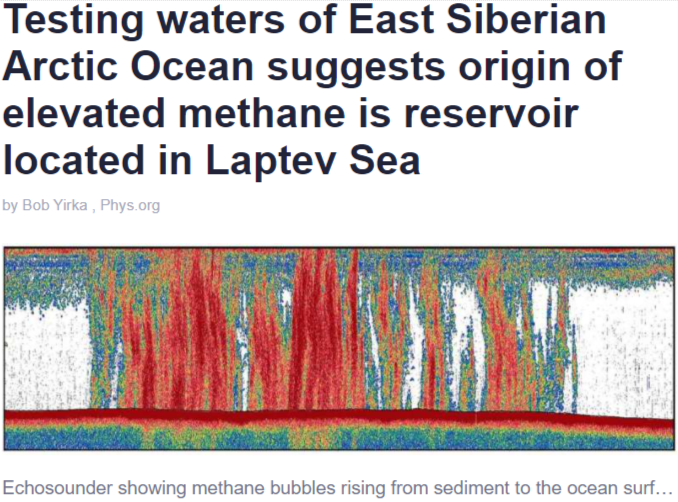
Atmospheric Methane Rise From Isoprene Demise Correlated With Collapse Of Ocean Pastures
Are all climate scientists hammers, seeing everything as a nail?
Climate Change gravy trains filled to overflowing with climate engineering business plans
But Nature has the best of ideas for how to care for her ‘blue planet’, restore her ocean pastures!
Healthy natural environments including ocean pastures have almost unlimited capacity to oxidize methane
There is a contingent of people concerned about climate change to whom methane is the boogeyman, baba yaga, gurumapa. They will point out that methane is a greenhouse gas with 25-84 times the ‘global warming’ potency as CO2. Their focus on ‘global warming’ drives them to create a fearful monster in methane as their Terran science suggests that methane rising in concentration in the atmosphere is driven by human technology. After all, our ‘natural gas’ is essentially methane, and our fossil fuel industry is so very careless in leaking vast amounts into the air. To make things all the scarier is the idea that ‘global warming’ is releasing more and more methane from natural sinks on land where warmer temperatures mean more decay and methane.
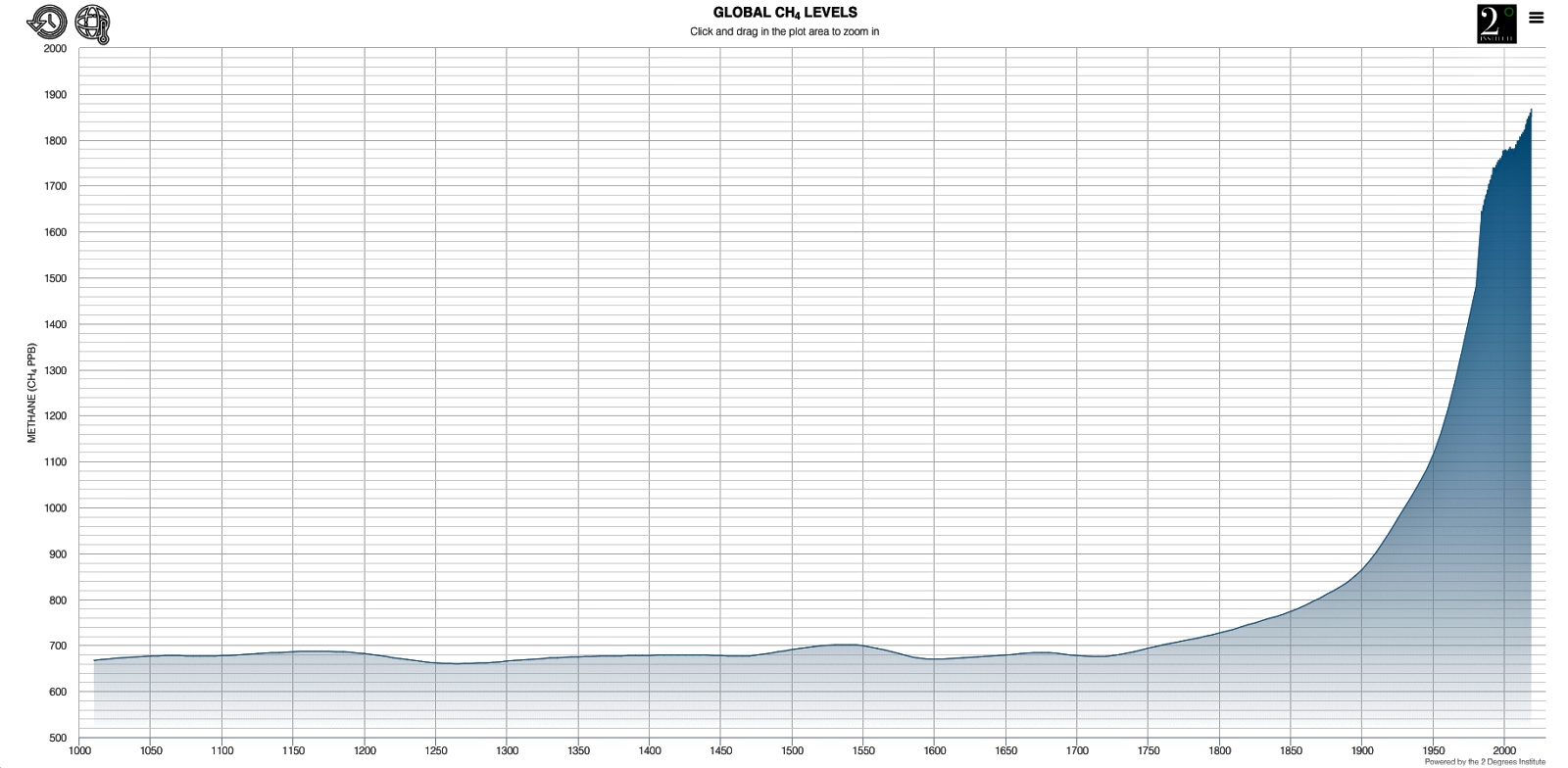
Global methane rising in the past 100 years and no one is quite sure why say many pundits. Click to read more.
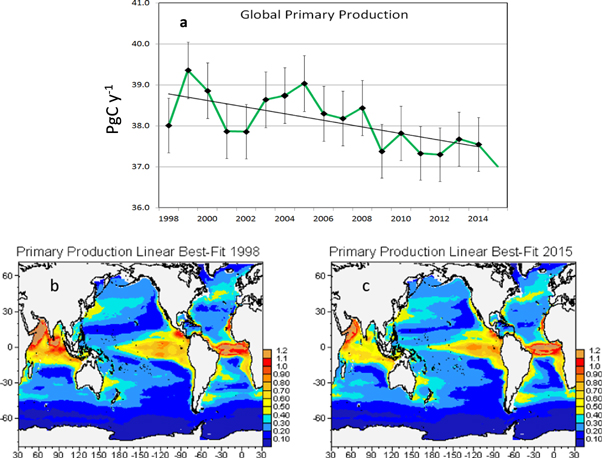
Ocean pasture productivity decline closely matches atmospheric methane increase. Something the ocean pastures release was holding methane at bay. By restoring ocean pastures to health we will reduce global warming methane!
Gaslighting For Climate Change, Competing Business Plans
You may have read the myriad proclamations that global warming is going to release a methane bomb from the Arctic ocean? Alas, what the real scientific data actually says is that the vast majority of methane from the Arctic’s Laptev Sea is NOT being released due to climate change. The methane has now been measured definitively and shown to be ancient geologic methane that is escaping from natural seeps and has almost certainly been doing so for millions of years!!! But hey, if you are in the business of marketing climate change clickbait that’s a bummer… better to hook your clickers by igniting that methane and gaslighting them with inflammatory methane fears.
Fear-mongering about all things to do with climate change has spawned a vast industry of new business ideas to sow about slowing climate change and be rewarded for doing so. Hundreds of billions are pouring into the climate change feeding troughs. Sadly the more costly a ‘climate change business plan’ is, seems to make it most popular. One such business plan is to build machines to spew highly reactive chemicals into the atmosphere at staggering costs where those chemically engineered antagonist chemicals will attack and destroy atmospheric methane.
The very idea that we might build countless smokestacks to inject new ‘good’ chemicals into the air to attack the ‘bad’ chemicals is startling. That this intentional pollution of the air with the promise ‘we’ll be careful’ seems incongruous to ideas of restoring the climate and the environment. I have been engaged in arguing against this with some science and business people in talking about this idea for a few years. My test is that anything we do to help save this planet needs to first and foremost be guided by Nature.
I have been working on eco-restoration ideas that assume Mother Nature is the best of all chemists and chemical engineers, and she is ALWAYS careful.
From a recent paper, Researchers Clarify Recycling Mechanism for Hydroxyl Radicals (scitechdaily.com), I recently pointed out to a friend that this paper talks about Natural Phytochemicals being powerful in reducing atmospheric methane. Isoprene is one such phytochemical. If you have ever smelled a forest or an orchard you have smelled isoprene.
One has to read between the lines in that paper with an understanding of what is not said in the paper but is implied.
The paper begins by stating, Researchers at the Max Planck Institute have now clarified exactly how hydroxyl radicals, which oxidize volatile organic compounds such as methane and isoprene, are recycled once they have finished their chemical cleaning duties. The research shows that isoprene, naturally released by plants, contributes to the reduction as well as to the formation of OH radicals and the recycling efficiency of OH radicals depends on isoprene quantity. In fact, plants produce so much isoprene that the annual natural plant emissions of isoprene equal that of all sources of methane.
“For the interaction between biosphere and atmosphere, the buffering of the OH radical quantity is very important, since it provides large forests (plant ecosystems) with the ability to maintain their self-cleaning capacity,” explains Domenico Taraborelli.
“Natural ecosystems are better buffered than we suspected”
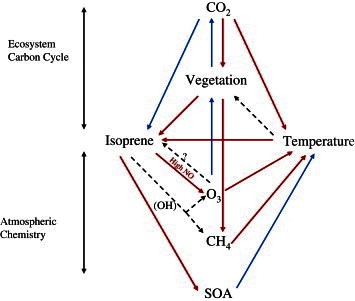
Isoprene has a very short lifetime in the atmosphere, mere minutes to hours. This makes it especially efficient at destroying methane CH4, reducing it to CO2.
The fact that this blue planet of ours retains its ability to clean itself in the face of air pollution is something that is likely to stand the global climate in good stead. Many volatile organic compounds, like methane, exert a strong greenhouse effect. In the course of climate change, aka global warming, they are likely to be released from natural sources in even greater quantities. However, the consequences of this could be less severe than we have assumed, thanks to Mother Nature and her isoprene.
As ecorestoration of trees and seas results in the release of more isoprene into the atmosphere methane can be expected to go down. According to the latest findings, a higher isoprene concentration leads to the production of more hydroxyl radicals, which clean the atmosphere of greenhouse gases.
“Our results also indicate that increasing isoprene emissions, which we expect from global warming, will not enhance the climate effect,” concludes Jos Lelieveld, Director at the Max Planck Institute for Chemistry. “This shows that natural ecosystems and their atmospheric environment are better buffered than we suspected.”
These Terran scientists are a bit like hammers, to which everything is a nail, they seem to only think about terrestrial systems.
They never speak of ocean plant ecosystems which are today already reduced by 50%! The rate of loss of ocean pasture plant life is equivalent to losing an ENTIRE AMAZON RAINFOREST every five years, since 1950. That means that when the ocean pastures are restored to historic levels of health and abundance their many-fold ‘Amazon Rainforest equivalence’ production of phytochemicals, including isoprene, will also be restored and will dramatically reduce global methane.
One might engage untested perhaps untestable artificial energy-intensive chemical engineering to remove methane from the air. But we can surely and simply help Mother Nature do what she does best using the free energy of photosynthesis in her vast ocean pasture systems to do more, better, faster.
The advantage ocean phytochemicals, especially when massively replenished, have over terrestrial chemistry is that the ocean is also always producing prodigious amounts of salt. As the ‘iron salt aerosol’ guys note a ‘…cene, or …prene’ molecule when associated with NaCl is multiplied in potency by the presence of the free radical Cl and is even more effective in reducing methane.
Bring Back The Marine Isoprene, and other vital bloom gases
A key aspect of phytochemical isoprene is that it is being produced and ending up in the atmosphere in an identical amount as methane. Or at least it used to be. Since isoprene and methane are antagonists one might say that they are, or should be in natural equilibrium. But the collapse of the ocean pastures has surely dramatically reduced the amount of isoprene in the atmosphere by at least 25%, likely more like 50%. This decline in ocean pasture isoprene could easily be a close correlation to increasing methane in the air. This is of course a hypothesis for an alternative non-terran path to explain methane build-up in the air being due to the collapse of ocean pastures as opposed to the simplistic ‘global warming’ methane release dogma.
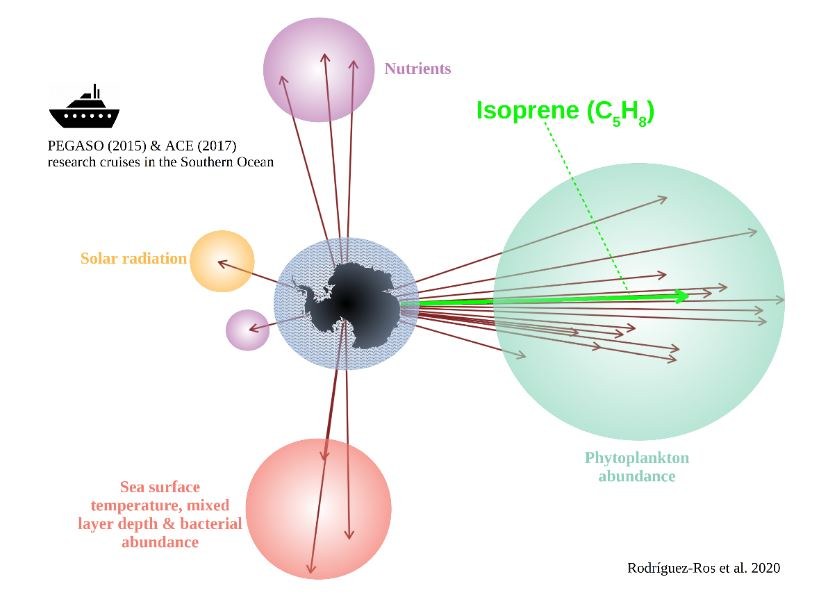
PS… Marine isoprene production is controlled by Fe availability. Macronutrients do not alter phytoplankton biomass isoprene. Click to read more…
My hypothesis is easily tested and proven and of course, is part of my OPR science plan. By restoring ocean pastures to historic health and abundance around the world we will bring back the fish, and perform a plethora of other vital ecosystem services like reducing the potent greenhouse gas methane.
Once the data is in hand and it speaks to us it will likely say, ‘Want to save the world? Bring back the fish and isoprene!’
More isoprene = less methane. Three years after the start of OPR we’ll be able to see it all clearly and explain it better. But on the ‘back of the envelope’ since there are about 600 million tonnes of methane going into the air every year restoring ocean pasture isoprene would easily destroy 5%-10% of that. With a GHG multiplier of 84 that might amount to about 3-5 billion tonnes of CO2e reduction or ~7% to 12% of the global GHG burden.
The next installment in this series will speak from the data of the phytoplankton ‘halogenic carbon gases’, another vital climate moderating gas created by Nature in her endless evolution and management of the ‘Goldilocks Zone’ of her Blue Planet. For more you might read our post about ocean pastures making vital clouds.









